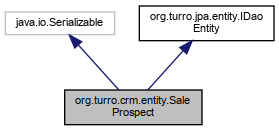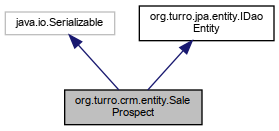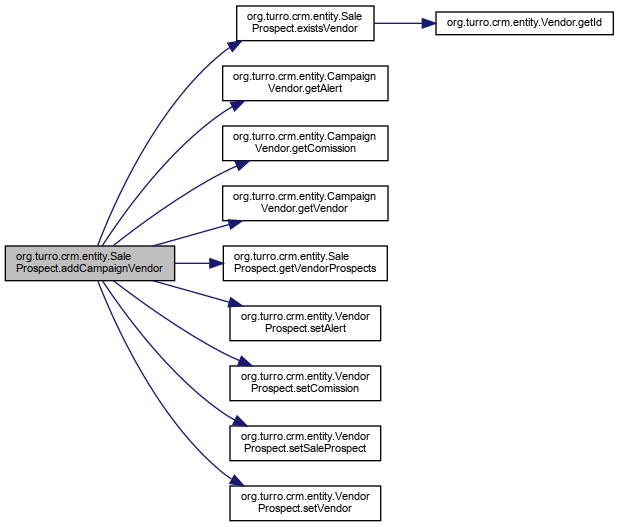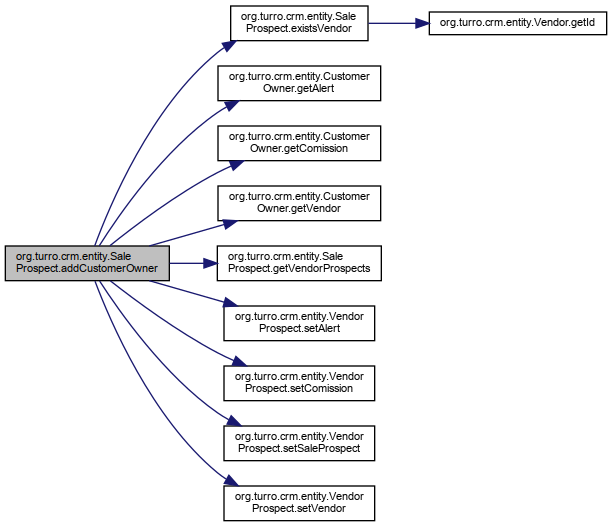- Author
- llturro
Definition at line 24 of file SaleProspect.java.
◆ addCampaignVendor()
| void org.turro.crm.entity.SaleProspect.addCampaignVendor |
( |
CampaignVendor |
campaignVendor | ) |
|
Definition at line 222 of file SaleProspect.java.
223 VendorProspect vp =
existsVendor(campaignVendor.getVendor());
225 vp =
new VendorProspect();
226 vp.setSaleProspect(
this);
227 vp.setVendor(campaignVendor.getVendor());
230 vp.setComission(campaignVendor.getComission());
231 vp.setAlert(campaignVendor.getAlert());
Set< VendorProspect > getVendorProspects()
VendorProspect existsVendor(Vendor vendor)
◆ addCustomerOwner()
| void org.turro.crm.entity.SaleProspect.addCustomerOwner |
( |
CustomerOwner |
customerOwner | ) |
|
Definition at line 210 of file SaleProspect.java.
211 VendorProspect vp =
existsVendor(customerOwner.getVendor());
213 vp =
new VendorProspect();
214 vp.setSaleProspect(
this);
215 vp.setVendor(customerOwner.getVendor());
218 vp.setComission(customerOwner.getComission());
219 vp.setAlert(customerOwner.getAlert());
◆ collections()
| Collection<Collection> org.turro.crm.entity.SaleProspect.collections |
( |
| ) |
|
◆ entityId()
| Object org.turro.crm.entity.SaleProspect.entityId |
( |
| ) |
|
◆ existsVendor()
Definition at line 234 of file SaleProspect.java.
236 for(VendorProspect vp : vendorProspects) {
237 if(vp.getVendor() !=
null && vp.getVendor().getId() == vendor.getId()) {
◆ getAttendees()
| Set<String> org.turro.crm.entity.SaleProspect.getAttendees |
( |
| ) |
|
◆ getBudget()
| double org.turro.crm.entity.SaleProspect.getBudget |
( |
| ) |
|
◆ getCampaign()
| Campaign org.turro.crm.entity.SaleProspect.getCampaign |
( |
| ) |
|
◆ getClosingDate()
| Date org.turro.crm.entity.SaleProspect.getClosingDate |
( |
| ) |
|
◆ getCustomer()
| Customer org.turro.crm.entity.SaleProspect.getCustomer |
( |
| ) |
|
◆ getDescription()
| String org.turro.crm.entity.SaleProspect.getDescription |
( |
| ) |
|
◆ getFullDescription()
| String org.turro.crm.entity.SaleProspect.getFullDescription |
( |
| ) |
|
Definition at line 166 of file SaleProspect.java.
167 return Strings.truncateAndWarn(description, 50) +
168 (customer ==
null ?
"" :
" (" + customer.
getName() +
")");
◆ getIAttendees()
| Collection<IContact> org.turro.crm.entity.SaleProspect.getIAttendees |
( |
| ) |
|
Contact Helpers
Definition at line 194 of file SaleProspect.java.
195 ArrayList<IContact> list =
new ArrayList<IContact>();
196 for(String s : attendees) {
197 IContact c = Contacts.getContactById(s);
198 if(c.isValid()) list.add(c);
◆ getId()
| long org.turro.crm.entity.SaleProspect.getId |
( |
| ) |
|
◆ getLastSaleAction()
| SaleAction org.turro.crm.entity.SaleProspect.getLastSaleAction |
( |
| ) |
|
Definition at line 175 of file SaleProspect.java.
177 return (
set !=
null && !
set.
isEmpty()) ?
set.last() :
null;
SaleActionSet getSaleActions()
◆ getProspectDate()
| Date org.turro.crm.entity.SaleProspect.getProspectDate |
( |
| ) |
|
◆ getSaleActions()
| SaleActionSet org.turro.crm.entity.SaleProspect.getSaleActions |
( |
| ) |
|
◆ getStage()
◆ getStageWrapper()
Definition at line 188 of file SaleProspect.java.
189 return new ProspectStageWrapper(
this,
new Date());
◆ getType()
◆ getUpdatedVendorProspects()
| Set<VendorProspect> org.turro.crm.entity.SaleProspect.getUpdatedVendorProspects |
( |
| ) |
|
Definition at line 180 of file SaleProspect.java.
182 Dao dao =
new CrmPU();
183 return dao.lazyLoader(SaleProspect.class,
this,
"vendorProspects").vendorProspects;
185 return vendorProspects;
◆ getVendorProspects()
| Set<VendorProspect> org.turro.crm.entity.SaleProspect.getVendorProspects |
( |
| ) |
|
◆ isEmpty()
| boolean org.turro.crm.entity.SaleProspect.isEmpty |
( |
| ) |
|
◆ setAttendees()
| void org.turro.crm.entity.SaleProspect.setAttendees |
( |
Set< String > |
attendees | ) |
|
◆ setBudget()
| void org.turro.crm.entity.SaleProspect.setBudget |
( |
double |
budget | ) |
|
◆ setCampaign()
| void org.turro.crm.entity.SaleProspect.setCampaign |
( |
Campaign |
campaign | ) |
|
◆ setClosingDate()
| void org.turro.crm.entity.SaleProspect.setClosingDate |
( |
Date |
closingDate | ) |
|
◆ setCustomer()
| void org.turro.crm.entity.SaleProspect.setCustomer |
( |
Customer |
customer | ) |
|
◆ setDescription()
| void org.turro.crm.entity.SaleProspect.setDescription |
( |
String |
description | ) |
|
◆ setIAttendees()
| void org.turro.crm.entity.SaleProspect.setIAttendees |
( |
Collection< IContact > |
contacts | ) |
|
Definition at line 203 of file SaleProspect.java.
205 for(IContact c : contacts) {
206 if(c.isValid()) attendees.add(c.getId());
◆ setId()
| void org.turro.crm.entity.SaleProspect.setId |
( |
long |
id | ) |
|
◆ setProspectDate()
| void org.turro.crm.entity.SaleProspect.setProspectDate |
( |
Date |
prospectDate | ) |
|
◆ setStage()
| void org.turro.crm.entity.SaleProspect.setStage |
( |
ProspectStage |
stage | ) |
|
◆ setType()
| void org.turro.crm.entity.SaleProspect.setType |
( |
ProspectType |
type | ) |
|
◆ setVendorProspects()
| void org.turro.crm.entity.SaleProspect.setVendorProspects |
( |
Set< VendorProspect > |
vendorProspects | ) |
|
The documentation for this class was generated from the following file:










